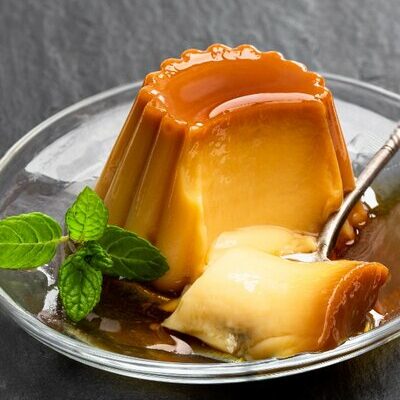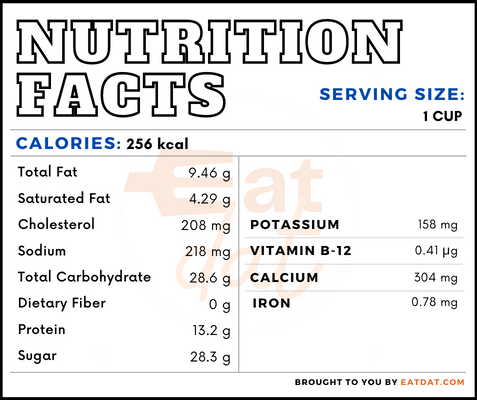
Custard
also known as Crème Anglaise
What is Custard?
Custard is a type of pastry cream that originated in the UK. It is made with milk, sugar, eggs, and cornstarch. Other ingredients may be included to add more flavor, including fruits, chocolate, vanilla, nuts, and spices like cinnamon and nutmeg. This cream usually has a thick consistency and a sweetish flavor.
- However, savory custards also exist and are used as fillings for dishes like quiche or pastries.
- Custard is an important ingredient in Boston Cream Pie.
The top 8 most popular custard brands include:
- Waitrose
- Ambrosia
- Bird’s
- Essential Waitrose
- Oatly
- Alpro
- Jude’s
- Aunt Bessie’s
Origin of custard
Custard was first invented by ancient Romans, who made it with milk, honey, eggs, and pepper. It spread through the rest of Europe over time. Later, during the 16th century, it gained immense popularity in Portugal. Monks and nuns used egg whites to starch their habits, which left a lot of egg yolks wasted, so they turned to make this dish. Crème brûlée appeared in the same century. Today, it is a popular dish in the UK, some parts of Europe, and South Asia.
Commercial production
Custard powder is available from different brands which is used to prepare the dish. Canned custard is also available.
Fresh custard is prepared with milk, eggs, sugar, and vanilla for the basic recipe. Other ingredients may be added for different variations. Cornflour is sometimes used to thicken the concoction. First, the vanilla is added to the milk, and warmed on a pan until it begins to simmer. Then, the vanilla is left to infuse while the egg yolks are mixed with sugar and beaten separately. Once mixed thoroughly, the milk is added to the beaten eggs and mixed again. This is once again put into a pan and heated at low flame until the liquid thickens. It can be served hot from the stove, or chilled and added to other desserts.
This dessert can be stored in the refrigerator for up to 2 days.
Nutrition
Nutritional profile for custard (1 cup):

Custard is rich in calcium, magnesium, phosphorous, potassium, sodium, selenium, niacin, folate, choline, vitamin A, retinol, carotene, cryptoxanthin, vitamin D, and lutein + zeaxanthin.
Milk is a nutrient-rich food that helps in keeping bones strong, regulate blood pressure and digestive functions. It contains casein and whey protein, the former promoting absorption of the calcium and minerals and the latter promoting muscle building. Regular consumption of milk may also help in reducing the risk of cardiovascular disease, stroke, hypertension, colorectal cancer, metabolic syndrome, obesity, and osteoporosis. However, it may increase the risk of prostate cancer, Parkinson’s disease, acne and Fe-deficiency anemia in infancy.
Also, eggs are rich in nutrients and contain more than 500 distinct proteins that assist in growth and regulates the digestive system. They are good for weight loss, and also help in preventing the risk of diseases such as hypertension and sarcopenia, and increases immunity.
Sugar can be good for the health of the brain, provided it is taken in balanced quantities. However, overconsumption of sugar can lead to an increase in the risk of heart diseases, diabetes, cancer, and other diseases. Additionally, it can lead to obesity, depression, and aging.
Recipes
Custard is a dish that comes in different varieties. It is versatile and can also be paired with different desserts. Here are a few recipes to try:
- Galaktoboureko
- Jam and Custard Doughnut
- Custard Tart
- Mille Feuille
- Crème Brûlée
- Quindim
- Bread Pudding
- Apple Sponge Eve’s Pudding
- Spotted Dick
- English Trifle
- Jam Roly Poly
- Sticky Toffee Pudding
- Leite de Creme
- Leche Flan
- Butterscotch Budino
- Zabaione
- Karpatka
- Bavarian Cream
FDA regulations
Sugar, also known as sucrose is made through crystallization from sugar cane or sugar beet juice that has been extracted by pressing or diffusion, then clarified and evaporated. Milk is defined as the lacteal secretion of healthy cows. It must be free of colostrum and must be pasteurized. White corn flour is the food prepared by so grinding and bolting cleaned white corn. For yellow corn flour, the same process is followed with yellow corn.
However, there is no standard of identity for eggs by the FDA. Moreover, the poultry products fall under the jurisdiction of the USDA.
References
What is Custard and Where is It From?, Backyard Poultry, https://backyardpoultry.iamcountryside.com/eggs-meat/what-is-custard-and-where-is-it-from/
Zhang, Xingxia et al. “Milk consumption and multiple health outcomes: umbrella review of systematic reviews and meta-analyses in humans.” Nutrition & metabolism vol. 18,1 7. 7 Jan. 2021, doi:10.1186/s12986-020-00527-y, https://www.ncbi.nlm.nih.gov/pmc/articles/PMC7789627/
Réhault-Godbert, Sophie et al. “The Golden Egg: Nutritional Value, Bioactivities, and Emerging Benefits for Human Health.” Nutrients vol. 11,3 684. 22 Mar. 2019, doi:10.3390/nu11030684, https://www.ncbi.nlm.nih.gov/pmc/articles/PMC6470839/
